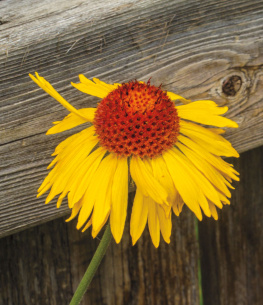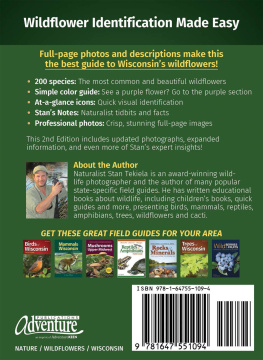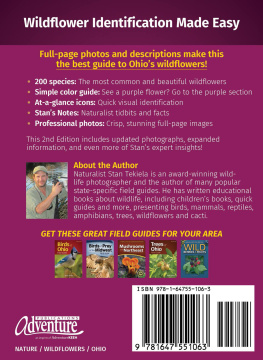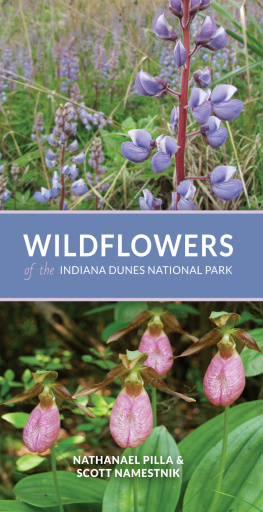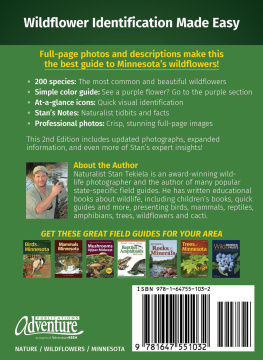Table of Contents
Landmarks
Popular Wildflowers of the Canadian Prairies
Copyright 2020 by Neil L. Jennings
For information on purchasing bulk quantities of this book, or to obtain media excerpts or invite the author to speak at an event, please visit rmbooks.com and select the "Contact" tab.
RMB | Rocky Mountain Books Ltd.
rmbooks.com
@rmbooks
facebook.com/rmbooks
Cataloguing data available from Library and Archives Canada
ISBN 9781771603522 (electronic)
All photographs are by the author unless otherwise noted.
We would like to also take this opportunity to acknowledge the traditional territories upon which we live and work. In Calgary, Alberta, we acknowledge the Niitsitapi (Blackfoot) and the people of the Treaty 7 region in Southern Alberta, which includes the Siksika, the Piikuni, the Kainai, the Tsuutina and the Stoney Nakoda First Nations, including Chiniki, Bearpaw, and Wesley First Nations. The City of Calgary is also home to Mtis Nation of Alberta, Region III. In Victoria, British Columbia, we acknowledge the traditional territories of the Lkwungen (Esquimalt, and Songhees), Malahat, Pacheedaht, Scianew, TSou-ke and WSNE (Pauquachin, Tsartlip, Tsawout, Tseycum) peoples.
All rights reserved. No part of this publication may be reproduced, stored in a retrieval system, or transmitted in any form or by any means electronic, mechanical, audio recording, or otherwise without the written permission of the publisher or a photocopying licence from Access Copyright. Permissions and licensing contribute to a secure and vibrant book industry by helping to support writers and publishers through the purchase of authorized editions and excerpts. To obtain an official licence, please visit accesscopyright.ca or call 1-800-893-5777.
We acknowledge the financial support of the Government of Canada through the Canada Book Fund and the Canada Council for the Arts, and of the province of British Columbia through the British Columbia Arts Council and the Book Publishing Tax Credit.
Disclaimer
It is up to the users of this guidebook to acquire the necessary skills for safe experiences and to exercise caution. The author and publisher of this guide accept no responsibility for your actions or the results that occur from anothers actions, choices, or judgments. If you have any doubt as to the safety of any given plant, avoidance is the best course of action.
This book is dedicated to our dear friend Carol Baker, whose cheerfulness, class and pluck in the face of seemingly insurmountable adversity stand as an inspiration to all of us. Still sorely missed after all this time.
Acknowledgements
I owe a debt of gratitude to a number of family members who contributed to this book by their continuous encouragement and support. Particular appreciation goes to my wife, Linda, who accompanied me on many flower outings and allowed me frequent absences from other duties in favour of chasing blooming flowers. My children, and, I am happy to say, their children, all deserve mention as well, given that they were often seconded to tramp around with me and bring me home alive. Thanks also go to many friends who encouraged me in my projects and often went into the field with me, according me a level of patience that was above and beyond the call of duty. I also wish to especially thank (or perhaps blame) the now departed S. Don Cahoon, who often shamed me with my ignorance and convinced me to educate myself about the beauty that resides in fields of wildflowers.
Introduction
This book is intended to be a field guide for the amateur naturalist to the identification of wild flowering plants commonly found in the prairie environments of western Canada and several of the border states of the USA. This is not a book for scientists. It is for the curious traveller who wants to become acquainted with the flowers encountered during outings. The book differs from most other field guides in that it makes no assumption that the reader has any background in things botanical. It is also small enough to actually carry in the field and not be a burden. I believe most people want to be able to identify the flowers they encounter because this enriches their outdoor experience. Some might think it a difficult skill to perfect, but take heart and consider this: you can easily put names and faces together for several hundred family members, friends, acquaintances, movie stars, authors, business and world leaders, sports figures etc. Wildflower recognition is no different, and it need not be complicated.
The book does not cover all of the species of wildflowers and flowering shrubs that exist here, but it does include a large representation of the more common floral communities that might be encountered in a typical day during blooming season. No book that I am acquainted with covers all species in any region, and indeed if such a source existed, it would be too large to be easily carried. Obviously, space will not permit a discussion of all such species, nor would it be pertinent for the amateur naturalist.
Do you know what this flower is called? is one of the most often asked questions when I meet people in the field. Hopefully, this book will enable the user to answer this question. Identification of the unknown species is based on comparison of the unknown plant with the photographs contained in the book, augmented by the narrative descriptions associated with the species pictured. In many instances the exact species will be apparent, while in other cases the reader will be led to plants that are similar to the unknown plant, thus providing a starting point for further investigation. For the purposes of this book, scientific jargon has been kept to a minimum. I have set out to produce the best photographic representations I could obtain, together with some information about the plant that the reader might find interesting, and that might assist the reader in remembering the names of the plants. In my view, what most people really want to know about wildflowers is what is this thing? and tell me something interesting about it. Botanical detail, while interesting and enlightening to some of us, will turn off many people.
The plants depicted in the book are arranged first by colour and then by family. This is a logical arrangement for the non-botanist because the first thing a person notes about a flower is its colour. All of the plants shown in the book are identified by their prevailing common names. Where I knew of other common names applied to any plant, I have noted them. I have also included the scientific names of the plants. This inclusion is made to promote specificity. Common names vary significantly from one geographic region to another, but scientific names do not. If you want to learn the scientific names of the plants to promote precision, thats fine. If not, no worries, but just be mindful that many plants have different common names applied to them depending on geography and local usage.
A few cautionary comments and suggestions:
While you are outdoors, go carefully among the plants so as not to damage or disturb them. Stay on the established trails; those trails exist to allow us to view the natural environment without trampling it to death. Many environments are delicate and can be significantly damaged by indiscriminately tromping around in the flora.
Do not pick the flowers. Leave them for others to enjoy.
Do not attempt to transplant wild plants. Such attempts are most often doomed to failure.
Do not eat any plants or plant parts. Do not attempt to use any plants or plant parts for medicinal purposes. To do so presents a potentially significant health hazard. Many of the plants are poisonous some violently so.

